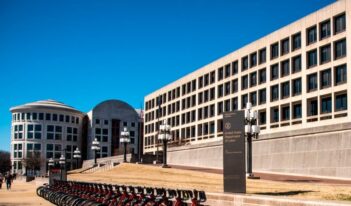
The Labor Department’s new rule sets forth a principles-based approach to regulating ESG investing.
In March, President Biden used his first presidential veto to uphold a federal rule laying out investing guidelines for retirement plan fiduciaries. President Biden’s veto stopped Congress’s attempt to nullify the rule under the Congressional Review Act.
The U.S. Department of Labor released the rule at issue in November 2022, in an attempt to clarify the circumstances under which certain fiduciaries can integrate environmental, social, and governance (ESG) considerations into their investment decision-making. This so-called ESG rule provides fiduciaries regulated by the Employee Retirement Income Security Act of 1974 (ERISA) with greater flexibility to integrate ESG considerations into their investment decision making.
Although the ESG rule provides more certainty about the extent to which fiduciaries can consider these types of factors, the Labor Department’s back-and-forth regulations in this particular arena, combined with current legal and political challenges to the ESG rule, makes it unclear whether or for how long this particular version of ESG guidance will survive.
ESG investing has been a topic of interest for investors over the past number of years. ESG investing strategies seek to incorporate ESG factors into investment decision-making to build a broader picture of an investment’s risks and opportunities.
Interest in ESG investing has skyrocketed in the past few years. In 2021, over $500 billion flowed into ESG-integrated funds, contributing to a 55 percent year-over-year growth in assets under management in ESG-integrated products. Experts predict that by 2024 almost half of all professionally managed assets will consider some form of ESG factors.
Historically, plan administrators have faced regulatory uncertainty around whether, and how, ERISA permits or precludes the use of ESG factors in making their decisions. ERISA requires retirement plan fiduciaries to discharge their decision-making duties in accordance with a duty of loyalty and a duty of prudence. The Labor Department interprets how those duties apply to specific investment situations by issuing regulations fleshing out the meaning of those duties as applied to different scenarios.
The Labor Department has a long history of going back and forth on the extent to which fiduciaries could consider ESG factors. Nevertheless, the Labor Department has been consistent in affirming that plan fiduciaries must make investment decisions in accordance with ERISA’s fiduciary duties of loyalty and prudence.
Specifically, the duty of loyalty requires that fiduciaries do not “subordinate the interests of the participants and beneficiaries in their retirement income or financial benefits under the plan to other objectives.” The duty of prudence requires that the fiduciary give “appropriate consideration to those facts and circumstances that, given the scope of such fiduciary’s investment duties, the fiduciary knows or should know are relevant to the particular investment or investment course of action involved.”
The latest ESG rule clarifies that ERISA-regulated fiduciaries can take into account ESG factors that are relevant to an investment’s financial performance. Although the ESG rule gives a (green) thumbs up to ESG investing in certain circumstances, it moves away from prior guidance that hyper-focused on ESG and it now provides a broader gloss on the appropriate fiduciary decision-making process.
That said, the new ESG rule is not devoid of guidance pertaining specifically to ESG. There are three key changes the ESG rule made from prior guidance that may have the greatest impact on plan sponsors and fiduciaries going forward.
First, the ESG rule clarifies that ESG factors may—but not must—be included in fiduciary decision-making. To comply with the ESG rule, a fiduciary must consider factors that are relevant to an investment’s risk-return, which may include certain ESG factors, leaving open the possibility that prudent fiduciaries might not consider ESG factors at all. This middle-of-the-road position makes room for fiduciaries to consider ESG when relevant and appropriate without imposing a mandate that they do so.
Second, the ESG rule removes documentation burdens that may have deterred fiduciaries from considering ESG factors in the past. If a fiduciary determines that certain ESG factors are financially relevant and that consideration of those factors would be prudent, the fiduciary no longer needs to comply with prior documentation requirements, such as the tie-breaker requirement or the proxy voting requirement.
For decades, Labor Department guidance on ESG investing included a “tie-breaker test” under which a fiduciary could consider ESG and other collateral, or non-financial, factors to break the tie between otherwise identical investment options. Prior guidance stated that a fiduciary could consider collateral benefits to break the tie between two otherwise “economically indistinguishable” investment choices or courses of action as long as the fiduciary complied with a burdensome documentation process.
The ESG rule changed the standard from “economically indistinguishable” to allow consideration of non-financial factors whenever both options “equally serve the financial interests of the plan.” The Labor Department explained in the preamble to its rule that the prior standard caused “a great deal of confusion, given that no two investments are the same in each and every respect.” In addition, the ESG rule removed the burdensome documentation process that accompanied the use of the tie-breaker, explaining in its preamble that the disclosure requirement singled out certain factors over other factors, “contrary to the principle of neutrality.”
In addition, the ESG rule reiterated a long-standing Labor Department principle that fiduciaries of plans that include shares of stock as part of the plan’s assets must manage shareholder rights related to those shares, including the right to vote proxies.
The ESG rule also removed a prior provision in earlier guidance stating that ERISA does not require the voting of every proxy or the exercise of every shareholder right. The changes to the proxy voting section reflect the overall neutral and principles-based approach of the ESG rule. They ease ERISA plan participation in proxy votes, as long as the issue up for vote—ESG or not—is financially relevant to the investment.
Finally, the ESG rule allows for consideration of participant preference when deciding what investments to offer in participant directed individual account plans. The ESG rule includes a provision never explicitly stated in prior Labor Department guidance that fiduciaries of participant-direct individual account plans do not violate their duty of loyalty simply by taking participant preferences into account. The preamble to the rule does emphasize, however, that the duty of prudence reigns supreme—a fiduciary cannot add an imprudent option just because participants would prefer it.
Although the Labor Department stated throughout the preamble to the ESG rule that the rule is intended to be neutral and principles-based with respect to ESG investing, recent state and federal actions indicate that the buck may not stop the regulatory back and forth over ERISA plan ESG investing.
In addition to the recent congressional attempt to nullify the ESG rule, more than a dozen states have enacted or proposed their own rules applying to ERISA-exempt state-regulated pension plans that seek to limit and restrict state actors and fiduciaries of state funds from using ESG factors. In the judicial arena, two different sets of plaintiffs—one, a coalition of states and the other, individual 401(k) plan participants—have filed separate lawsuits in federal court challenging the legality of the Labor Department’s ESG rule.
Fiduciaries seeking to consider ESG factors as part of their decision-making face a federal regulation that appears to green-light certain types of ESG investing strategies but also competing state regulations cautioning fiduciaries to slow down the ESG considerations. This dynamic landscape introduces new complexities for compliance-minded fiduciaries seeking to integrate a broad set of factors into the decisions they make on behalf of ERISA-regulated retirement plans.
This essay is part of a five-part series entitled, ESG and Retirement Plan Investing.





